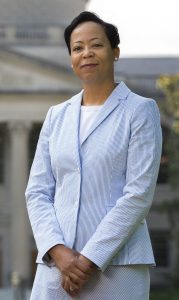University Librarian Elaine Westbrooks is on a mission to open Carolina’s research to all
This interview was originally published October 11, 2019, on The Well, the University’s news source for faculty and staff.

For decades, universities have been part of an academic publishing ecosystem in which their researchers submit studies and scholarly papers to peer-reviewed academic journals. Publishers do not pay scholars for conducting the research or for reviewing the work of their peers. And when journals do publish research, the content is generally restricted to only its subscribers. University libraries subscribe to thousands of journals, paying annual fees of as much as $40,000 per journal, so that faculty, staff and students can access the research produced on their campus.
“There’s really no other industry where the creator and the consumer are one and the same, but the final product is apart from the creator and the consumer,” said University Librarian Elaine Westbrooks. “That cycle has made publishers quite wealthy.”
In an era of rising costs and declining revenues, the traditional model of academic publishing is unsustainable for universities, Westbrooks said. Now, Carolina is among the academic institutions seeking to challenge the status quo and innovate for the public good.
The University’s contract with Elsevier, one of the big five academic publishers who control the production of scholarly journals, expires Dec. 31. Other publisher agreements will soon follow, and earlier this year Westbrooks indicated that any new contracts will be closely scrutinized. Over the last several months, she and other librarians have met with dozens of groups across campus to learn more about how they want to access information.
Upcoming town halls allow the campus community to share input. All three town halls will be in Room 214, Davis Library and are accepting registrations:

The Well recently sat down with Westbrooks to talk about the future of academic publishing and how it will impact the University’s mission of research, teaching and service.
Q: What is the message you want to send to University faculty about the current situation?
A: I hope our scholars realize that this is something that has to be done. This is the tipping point for us. The money is not there to support the status quo. I’ve heard from many faculty who agree that that we need to change this system that we have.
The current model is unsustainable for universities and is inconsistent with the values of a public university. We’re “of the public, for the public,” designed to serve the state and the citizens of the state. So, I feel as though we have no choice but to transform this system to critique what we’ve done. That critique is going to have some consequences, which I think are good.
Q: What are you looking for in a new contract with Elsevier?
A: Elsevier is the world’s biggest publisher of scientific information, and we have a multimillion-dollar contract with them. Given its relevance to science, technology and health care, it is at the top of our list. The subscription cost of journals is rising at a rate three to four times inflation. We’re negotiating with Elsevier to find out what kind of license we can sign that will be affordable, sustainable, promotes open access and is transparent. Those are the four values that we have set. We’re at a tipping point where it’s just not possible to keep doing business as usual.
Q: What’s “business as usual” for subscriptions?
A: It’s like cable TV. They’d combine many journals into a single big package and we would just say, “Yes, we’ll take that package.” At the time, it was advantageous and nondisclosure agreements kept us from comparing deals with other libraries. Now we have to be more selective. It’s great to have all these titles, but if we only really need the premium titles, then it’s not a good use of funds. We’re really focused on the quality, not the quantity.
Q: What changes do you foresee in the way that our community consumes research?
A: What really matters to most scholars and students is how we deliver relevant content when they need it. And that’s a key part — when you need it, not just in case you need it. Moving forward, we may not have every single journal or article on the premises at this very second. In fact, we don’t right now. But we’ll get it for you. In some cases, it takes 48 hours, in some cases 24 hours, in some cases just a couple of hours. But we have the technology to acquire content very quickly and send it to your email address at no charge to you.
Q: What does this mean for our faculty and researchers as creators of the content?
A: Typically, when you get your paper accepted by a journal, the first thing the publisher wants you to do is to hand over your rights. This can often be negotiated, and it would be incredibly gratifying to see our scholars own the rights to their own scholarship and allow others to have access to it. We also want to eliminate what we call “double dipping” by the publisher. That’s when we pay for a title, and researchers also pay the publisher a fee to make that same research open access. If the research is sponsored by a public agency such as the NSF or NIH, then the publisher is asking us to pay two more times for taxpayer-funded research.
Q: What is open access and why is it important?
A: Scholars write to be read. This research is life changing. And the more locked up it is, the less impact it can have. We’re advocating for open access because the more people who read your research, the more that knowledge can be applied, built upon or challenged. It’s a win-win. I believe that open access can be truly transformational.
Different open access types are described using a color system. Green open access means that you can post or disseminate your research through a third party freely. One way to do that is the Carolina Digital Repository. Any scholar at this University can post their articles there. The work is indexed and the world can find it.
The second kind is gold open access. With gold, you pay the publisher a fee—anywhere from $70 to $6,000—and your journal article will be open to the world.
The third version of open access is platinum. With platinum, a journal is open for everyone, with zero barriers. You don’t need to pay a fee to publish it open access.
Q: What other options are you looking at?
We are seeking to partner with publishers who are willing to revisit their current models and help the University Libraries create a sustainable system where content is affordable as well as open. We want to eliminate or reduce the amount of “double dipping” that is taking place. Finally, we want to work with publishers who value authors’ rights and do not believe that authors must transfer their copyright to them in exchange for publication.
The technology enables us to have a more equitable system that disseminates knowledge quickly, advances humanity and generates revenue for publishers. This is certainly possible in my lifetime, so why wouldn’t Carolina be a leader?

